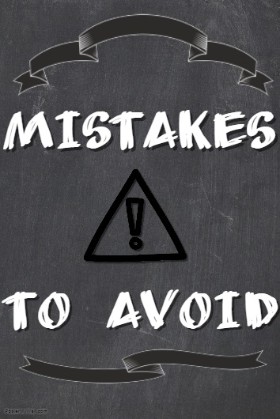Leasing - Mistakes to Avoid

It is important to make sure you take your time, go over all of the informtion, and don't let the dealer pressure you into anything.
This section lists some of the most common mistakes that people make when leasing as well as some misleading dealership or leasing company tactics, and how you can avoid falling victim to them.
Dealership and Leasing Company Fees
Lease deals, especially promotional ones or those subsidized by the manufacturer, can often have very low profit margin for the dealership, tempting them to make up for it with a number of additional fees.
Almost all leases are subject to an acquisition fee or a bank fee, as well as sales tax and the state registration fee. Many dealerships will also charge a dealer or documentation fee. Other than those fees, there should be no other fees either due at signing or rolled into your monthly payments.
When you are reviewing your lease deal, be sure to check for any additional delivery fees, dealer fees or sales agent fees that may be added on to the deal. Those are almost always just a way to get you to pay more for the car and you should simply refuse to pay them.
Even the dealer documentation fee can often be negotiated, though some dealers - usually those part of a large chain - may not be allowed to do so by their corporate management.
Leasing and Dealer Tricks

Car dealerships are in the business of making money, and have developed many tactics to try to maximize their profits. In addition to adding fees, dealerships have a full range of tricks and high-pressure sales tactics that are designed to wear away at your resolve and get you to accept a less favorable deal just to get it over with.
Those include classic ones such as losing the keys to your trade-in vehicle, making you wait while they talk to a manager or setting arbitrary deadlines such as “This deal is only available today!”. There are also some that are exclusive to leasing.
Often, dealerships will simply present a lease deal in the form of a down payment and a monthly payment number without itemizing the various items or even letting you know the sale price of the car.
This makes it difficult to negotiate on anything other than payments, which is more favorable to the dealership, as well as conceal other tricks, such as undervaluing your trade-in, not giving you the full value of discounts or rebates, or increasing the money factor.
If you are presented with a lease deal like that, simply ask for a version with an itemized list or have them write out the sale price, trade-in value, residual value and the money factor on the sheet together with the payments. Then, you can see exactly how the deal is put together and check it over with the formulas available earlier in this guide.
Another dealership trick that is common with leases is adding various optional insurance or service contract products to the deal without telling you. Because most lease customers simply buy based on the monthly payment, those high-profit items can easily be hidden in the monthly payment.
When you request an itemized list of the various lease costs, these should be listed. If they are not, then you won’t be able to recreate the payments the dealer is offering, tipping you off to the fact that something is wrong.
Balloon Payment Financing is not a Lease
Another trick to keep an eye out for is balloon payment financing. This is not a type of lease, but will sometimes be presented as such, or as a similar alternative. In fact, it is a very different sort of contract. It is a finance contract that, unlike normal financing, consists of a number of small payments and one large payment at the end.

Like a lease, it comes with low monthly payments. However, once the balloon finance contract ends, instead of returning the car to the dealership, you are instead obligated to pay the rest of the loan balance. You can easily identify a balloon payment financing because it will use finance terminology, such as interest rate instead of money factor. It is also required to be clearly labelled as such in the contract.
Like with an open-end lease, the main drawback of a balloon payment financing is that it puts all of the risk on the buyer instead of the leasing company. Dealerships rarely try to offer a balloon payment finance as an alternative to a lease, but may do so for buyers that may not qualify for a lease due to their low credit score. However even in that case, the balloon payment financing is rarely a good option.
Leasing and Insurance
An important thing to know before you sign your contracts and begin your lease is the insurance coverage you need. Often, you require a higher degree of insurance for a leased vehicle than a financed one, and the requirements can be different for different leasing companies. A quick check to make sure that you have the correct coverage can save you a lot of headaches later on when you find yourself in an accident.
A related item that you want to check off your final pre-signing checklist is GAP insurance. GAP insurance pays for the difference between your insurance payout and the remaining balance on your lease in case your vehicle is declared a total loss after an accident. As a side effect of the low payments that leases offer, they have negative equity for the majority of their duration, which can be an unexpected shock after an accident.
Many leases include either GAP insurance or a gap waiver that absolves you of the responsibility for the rest of the balance in the case of a total loss. It can also be a part of your current auto insurance as well. If neither is the case, make sure that you purchase a separate gap insurance policy either from the leasing company or your insurance company to cover you in case you get into an accident in your leased car.
Excessive Wear and Tear Charges
A common fear for many potential leasing customers is being charged excessively for wear and tear on their car. That is usually very uncommon, with the average driver facing little if any charges. The wear and tear charges also rarely come as a surprise. You can schedule the inspection of your car well in advance of the lease end date, giving you plenty of time to fix any significant damage.
Your leasing contract will also have a fairly comprehensive list of items that you can be charged for at the end of the lease. Familiarizing yourself with that list and the inspection report will give you a good sense of how much you could be charged for excess wear and tear.
However, the best way to avoid wear and tear charges is simply to take good care of your car. Avoid driving your leased vehicle in difficult terrain or areas with hazards that can cause permanent damage, such as loose gravel or low-hanging tree branches. Leasing contracts are designed with the average driver in mind, and most people will find keeping their car within the guidelines to be relatively easy.
Lease Term and Warranty Term
A common mistake many buyers make when leasing is having a leasing term that is slightly longer than the warranty term of the car. Keeping the car under warranty the entire time you drive it is one of the major attractions of leasing, making it a much better value to lease for the same term as the warranty. If it makes more sense for you to lease a car for a longer period, just keep in mind that you could be on the hook for major repairs if a problem crops up after the warranty term is over.
Shop Around
One of the best ways to avoid most of the above problems is to get quotes from multiple dealers before you sign anything. A lot of customers assume that if they are purchasing from a franchise dealership, such as Toyota, that each store will have the exact same deal. This is a big mistake.
Each dealership has different terms with the manufacturer depending on a lot of factors such as location and volume. Also, certain dealerships may be looking to unload vehicles they have had on their lots for too long. The fact is, it would be very hard to go into two different dealerships and come out with the exact same lease deal.
This is a great way to compare all of the different factors that we have talked about. One dealer might have higher fees than another, or even extra fees that the others don’t have. We have seen one dealer offering thousands more for a trade than the others simply because they had another customer looking to buy that exact used car.
Once you have several quotes, one of the best ways to save is to tell the dealers about your quotes. Although some customers don’t like to do this as they may consider it confrontational, this is not true. The fact is, salespeople see this every day and will want to work with you to keep your business. It is a great way to keep dealers honest, get fees waived, or even free oil changes.
